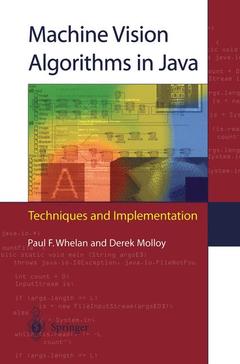1. An Introduction to Machine Vision.- 1.1 Human, Computer and Machine Vision.- 1.2 Vision System Hardware.- 1.3 Vision System Software.- 1.4 Machine Vision System Design.- 1.4.1 Image Acquisition.- 1.4.2 Image Representation.- 1.4.3 Image Processing.- 1.4.4 Image Analysis.- 1.4.5 Image Classification.- 1.4.6 Systems Engineering.- 1.5 NeatVision: Where Java meets Machine Vision.- 1.5.1 NeatVisions Graphical User Interface (GUI).- 2. Java Fundamentals.- 2.1 The History of Java.- 2.1.1 What Makes Java Platform Independent?.- 2.1.2 The Just-In-Time Compiler.- 2.1.3 The Sun Java Software Development Kit (Java SDK).- 2.2 Object-oriented Programming.- 2.2.1 Encapsulation.- 2.2.2 Classes.- 2.2.3 Objects.- 2.2.4 Inheritance.- 2.2.5 Polymorphism.- 2.2.6 Abstract Classes.- 2.3 Java Language Basics.- 2.3.1 Variables.- 2.3.2 Access Control.- 2.3.3 Java Types.- 2.3.4 Java Operators.- 2.3.5 Java Comments.- 2.3.6 The super and this Keywords.- 2.3.7 Java Arrays.- 2.3.8 The “Object” and “Class” Classes.- 2.3.9 Interfaces.- 2.3.10 Packages.- 2.4 Applications and Applets.- 2.4.1 Writing Applications.- 2.4.2 Applets.- 2.4.3 An Applet and an Application?.- 2.5 Java and Image Processing.- 2.5.1 The Canvas Class.- 2.5.2 Java and Images.- 2.5.3 Image Producers and Image Consumers.- 2.5.4 Recovering Pixel Data from an Image Object.- 2.5.5 Recreating an Image Object from an Array of Pixels.- 2.6 Additional Classes.- 2.6.1 ColorModel.- 2.6.2 ImageFilter.- 2.6.3 CropImageFilter.- 2.6.4 RGBImageFilter.- 2.6.5 FilteredImageSource.- 2.7 Double Buffering.- 2.8 Recent Additions to Java for Imaging.- 2.8.1 Java2DAPI.- 2.8.2 Working with the Java 2D API.- 2.8.3 Renderable Layer and Rendered Layer.- 2.8.4 Java Advanced Imaging API (JAI).- 2.8.5 JAI Functionality.- 2.9 Additional Information on Java.- 2.10 Conclusion.- 3. Machine Vision Techniques.- 3.1 Elementary Image Processing Functions.- 3.1.1 Monadic, Point-by-point Operators.- 3.1.2 Intensity Histogram.- 3.1.3 Look-up Tables (LUT).- 3.1.4 Dyadic, Point-by-point Operators.- 3.2 Local Operators.- 3.2.1 Linear Local Operators.- 3.2.2 Non-linear Local Operators.- 3.2.3 Edge Detectors.- 3.2.4 N-tuple Operators.- 3.2.5 Edge Effects.- 3.2.6 Grey Scale Corner Detection.- 3.3 Binary Images.- 3.3.1 Boolean Operators.- 3.3.2 Connected Component (Blob) Analysis.- 3.3.3 Measurements on Binary Images.- 3.3.4 Run-length Coding.- 3.3.5 Shape Descriptors.- 3.4 Global Image Transforms.- 3.4.1 Geometric Transforms.- 3.4.2 Distance Transforms.- 3.4.3 Hough Transform.- 3.4.4 Two-dimensional Discrete Fourier Transform (DFT).- 3.5 Conclusion.- 4. Mathematical Morphology.- 4.1 Binary Mathematical Morphology.- 4.1.1 Dilation and Erosion.- 4.1.2 Hit-and-Miss Transform.- 4.1.3 Opening and Closing.- 4.1.4 Skeletonisation.- 4.1.5 Structuring Element Decomposition.- 4.1.6 Interval Coding.- 4.2 Grey Scale Mathematical Morphology.- 4.2.1 Basic Grey Scale Operators.- 4.2.2 Noise Removal using Grey Scale Morphology.- 4.2.3 Morphological Gradients.- 4.2.4 Point-Pairs.- 4.2.5 Top-Hat Transform.- 4.3 Morphological Reconstruction.- 4.3.1 Conditional Dilation.- 4.3.2 Geodesic Dilation.- 4.3.3 Geodesic Erosion.- 4.3.4 Reconstruction by Dilation.- 4.3.5 Reconstruction by Erosion.- 4.3.6 Ultimate Erosion.- 4.3.7 Double Threshold.- 4.3.8 Image Maxima.- 4.3.9 Image Minima.- 4.4 Morphological Segmentation.- 4.4.1 Skeleton Influence by Zones (SKIZ).- 4.4.2 Watershed Segmentation.- 4.5 Case Study: Geometric Packing.- 4.5.1 Geometric Packer Implementation.- 4.6 Morphological System Implementation.- 4.7 Conclusion.- 5. Texture Analysis.- 5.1 Texture and Images.- 5.2 Edge Density.- 5.3 Monte-Carlo Method.- 5.4 Auto-Correlation Function (ACF).- 5.5 Fourier Spectral Analysis.- 5.6 Histogram Features.- 5.7 Grey Level Run Length Method (GLRLM).- 5.8 Grey Level Difference Method (GLDM).- 5.9 Co-occurrence Analysis.- 5.9.1 Energy, or Angular Second Moment.- 5.9.2 Entropy.- 5.9.3 Inertia.- 5.9.4 Local Homogeneity (LH).- 5.10 Morphological Texture Analysis.- 5.10.1 Morphological Ratio.- 5.10.2 Granularity.- 5.11 Fractal Analysis.- 5.12 Textural Energy.- 5.13 Texture Spectrum Method.- 5.14 Local Binary Patterns (LBP).- 5.15 Random Field Models.- 5.16 Spatial/Frequency Methods.- 5.17 Autoregressive Model.- 5.18 Structural Approaches to Texture Analysis.- 5.19 Conclusion.- 6. Colour Image Analysis.- 6.1 Colour Cameras.- 6.2 Red-Green-Blue (RGB) Colour Representation.- 6.2.1 Maxwell’s Colour Triangle.- 6.2.2 One-dimensional Histograms: Colour Separations.- 6.2.3 Two-dimensional Scattergrams.- 6.3 Hue-Saturation-Intensity (HSI) Colour Representation.- 6.3.1 Colour Scattergrams.- 6.4 Opponent Process Representation.- 6.5 YIQ Colour Representation.- 6.6 YUV Colour Representation.- 6.7 CIE Chromaticity Diagram.- 6.8 CIEXYZ Colour Representation.- 6.9 CIELUV Colour Representation.- 6.10 CIELAB Colour Representation.- 6.11 Spatial CIELAB Colour Representation.- 6.11.1 Segmenting Colour Textures.- 6.12 Programmable Colour Filter (PCF).- 6.12.1 PCF Implementation.- 6.12.2 Recognising a Single Colour.- 6.12.3 Noise Effects.- 6.12.4 Colour Generalisation.- 6.13 Conclusion.- 7. NeatVision: Visual Programming for Machine Vision.- 7.1 Visual Programming in Neat Vision.- 7.1.1 Input and Output Components.- 7.1.2 Processing Components.- 7.1.3 Flow Control Components.- 7.1.4 System Development.- 7.1.5 Sample Programme.- 7.2 Java Programming in NeatVision.- 7.2.1 Data Flow Programming.- 7.2.2 Standard Component Architecture.- 7.2.3 Adding Functionality.- 7.2.4 Examples.- 7.3 The Neat Vision Application.- 7.3.1 Visual Programming in NeatVision.- 7.3.2 Image Processing.- 7.3.3 Other User Interfaces.- 7.3.4 The Integrated Software Development Environment.- 7.3.5 The Help Viewer.- 7.4 Sample Applications.- 7.4.1 Low-level Programming.- 7.4.2 High-level Programming.- 7.4.3 Isolating the Largest Item in an Image.- 7.4.4 Bottle-top Inspection.- 7.4.5 Plant-stem Location.- 7.5 Conclusion.- A. NeatVision Graphic File Formats.- B. NeatVision Imaging API Specification.- C. NeatVision Components.- References.



